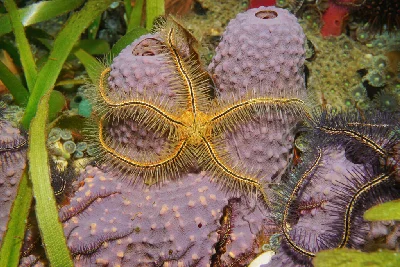Ophiuroidea
Brittle stars, serpent stars, or ophiuroids (from Latin ophiurus 'brittle star'; from Ancient Greek ὄφις (óphis) 'serpent', and οὐρά (ourá) 'tail'; referring to the serpent-like arms of the brittle star) are echinoderms in the class Ophiuroidea, closely related to starfish. They crawl across the sea floor using their flexible arms for locomotion. The ophiuroids generally have five long, slender, whip-like arms which may reach up to 60 cm (24 in) in length on the largest specimens.
The Ophiuroidea contain two large clades, Ophiurida (brittle stars) and Euryalida (basket stars). Over 2,000 species of brittle stars live today. More than 1,200 of these species are found in deep waters, greater than 200 m deep.
The ophiuroids diverged in the Early Ordovician. Ophiuroids can be found today in all of the major marine provinces, from the poles to the tropics. Basket stars are usually confined to the deeper parts of this range; Ophiuroids are known even from abyssal (>6,000 m) depths. However, brittle stars are also common members of reef communities, where they hide under rocks and even within other living organisms. A few ophiuroid species can even tolerate brackish water, an ability otherwise almost unknown among echinoderms. A brittle star's skeleton is made up of embedded ossicles.
Of all echinoderms, the Ophiuroidea may have the strongest tendency toward five-segment radial (pentaradial) symmetry. The body outline is similar to that of starfish, in that ophiuroids have five arms joined to a central body disk. However, in ophiuroids, the central body disk is sharply marked off from the arms. The disk contains all of the viscera. That is, the internal organs of digestion and reproduction never enter the arms, as they do in the Asteroidea. The underside of the disk contains the mouth, which has five toothed jaws formed from skeletal plates. The madreporite is usually located within one of the jaw plates, and not on the upper side of the animal as it is in starfish. The ophiuroid coelom is strongly reduced, particularly in comparison to other echinoderms.
The vessels of the water vascular system end in tube feet. The water vascular system generally has one madreporite. Others, such as certain Euryalina, have one per arm on the aboral surface. Still other forms have no madreporite at all. Suckers and ampullae are absent from the tube feet.
The nervous system consists of a main nerve ring which runs around the central disk. At the base of each arm, the ring attaches to a radial nerve which runs to the end of the limb. The nerves in each limb run through a canal at the base of the vertebral ossicles. Most ophiuroids have no eyes, or other specialised sense organs. However, they have several types of sensitive nerve endings in their epidermis, and are able to sense chemicals in the water, touch, and even the presence or absence of light. Moreover, tube feet may sense light as well as odors. These are especially found at the ends of their arms, detecting light and retreating into crevices.
The mouth is rimmed with five jaws, and serves as an anus (egestion) as well as a mouth (ingestion). Behind the jaws is a short esophagus and a stomach cavity which occupies much of the dorsal half of the disk. Digestion occurs within 10 pouches or infolds of the stomach, which are essentially ceca, but unlike in sea stars, almost never extend into the arms. The stomach wall contains glandular hepatic cells. Ophiuroids are generally scavengers or detritivores. Small organic particles are moved into the mouth by the tube feet. Ophiuroids may also prey on small crustaceans or worms. Basket stars in particular may be capable of suspension feeding, using the mucus coating on their arms to trap plankton and bacteria. They extend one arm out and use the other four as anchors. Brittle stars will eat small suspended organisms if available. In large, crowded areas, brittle stars eat suspended matter from prevailing seafloor currents. Many species in the family Ophiuridae are carnivorous. Ophiura Linnaeus hunts epibenthic animals and the Antarctic Ophiosparte gigas is an active predator. Ophiura albida Forbes and Ophiura sarsii Lütken eat both infaunal prey, carrion, and seafloor organic matter, and Ophionereis reticulata is omnivorous and feeds on algae, polychaetes, and detritus. In basket stars, the arms are used to sweep food rhythmically to the mouth.

